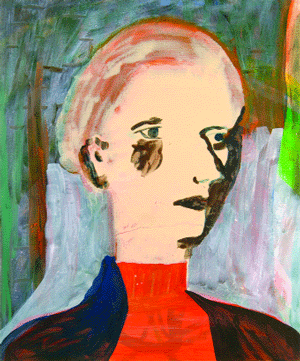Volume 5, Number 25 | June 22 – 28, 2006
GALLERY
Jackie Gendel
“Portraits”
Jeff Bailey Gallery
511 W. 25th St., #207
Tue.-Sat. 11 a.m.-6 p.m.
Through Jul. 1
212-989-1056
Jackie Gendel’s mid-century modernism
“Portraits,” Jackie Gendel’s exhibition of at the Jeff Bailey Gallery, demonstrates the pleasures of long hours spent alone in the studio, teasing out new directions from what has come before. Gendel’s earlier works consisted of linear images drawn in oil and wax and were more akin to engraving than to traditional painting. In her current exhibition of 12 easel-sized paintings, the artist takes her interest in mark-making and gesture in an entirely new direction. Rather than relying on the graphic toggle of black on white, Gendel now seems to revel in the liquidity of paint and historical implications of color.
Multiple iterations of loose, thinned paint cover, carve out, and recover faces from the murky surfaces, making for mask-like portraits that are shifty, strange, and luminous. Lying on top of fleshy abstract shapes, a few strokes are all that’s needed to delineate a pair of eyes, a nose, and a mouth.
The speed of Gendel’s fluid black line flirts with illustration—Moira Kalman comes to mind—creating a lack of specificity that prevents our identification with the subject. Instead of likenesses of particular individuals, Gendel’s paintings look like pictures of portraits. Heads are centered comfortably within the familiar vertical of the picture frame, conforming to the standard dictates of portraiture. However, instead of underlining the primacy of the human face, shifting background planes seem to corrode and distort the figure.
In “Wakefield,” slushy tide lines of color mixed with mineral spirits cause the pale oval face to detach and glow against a moody landscape. A motley transparent shape literally jumps the picture plane in “The Veil,” squeezing the face behind into an anxious exclamation mark. “Woman” has Gendel indulging in a moment of 1950s chic—a brushy chignon and arch countenance emerges out of interlocking planes of teal, brown, and gold. Such evident references to Picasso’s women are also tempered by a diffuse, melancholy attachment to mid-century European painting. In “Tourists” and “Conversation,” one catches glimpses of painter Marie Laurencin’s 1909 portrait of the poet, Apollinaire, as well as scenes from Charlotte Salomon’s epic Holocaust narrative.
“Rot,” the most recent painting in the group, again echoes the structure of Picasso’s classic portraits. Yet Gendel has repeatedly scratched over the young woman’s profile with a dirty brush, a half-hearted erasure that reinforces the abstract nature of the image. Given the long, venerated history of the form, painters are always going backward to push their work forward. Gendel’s loving recuperation of mid-century Modernism puts her right on track.
gaycitynews.com


































